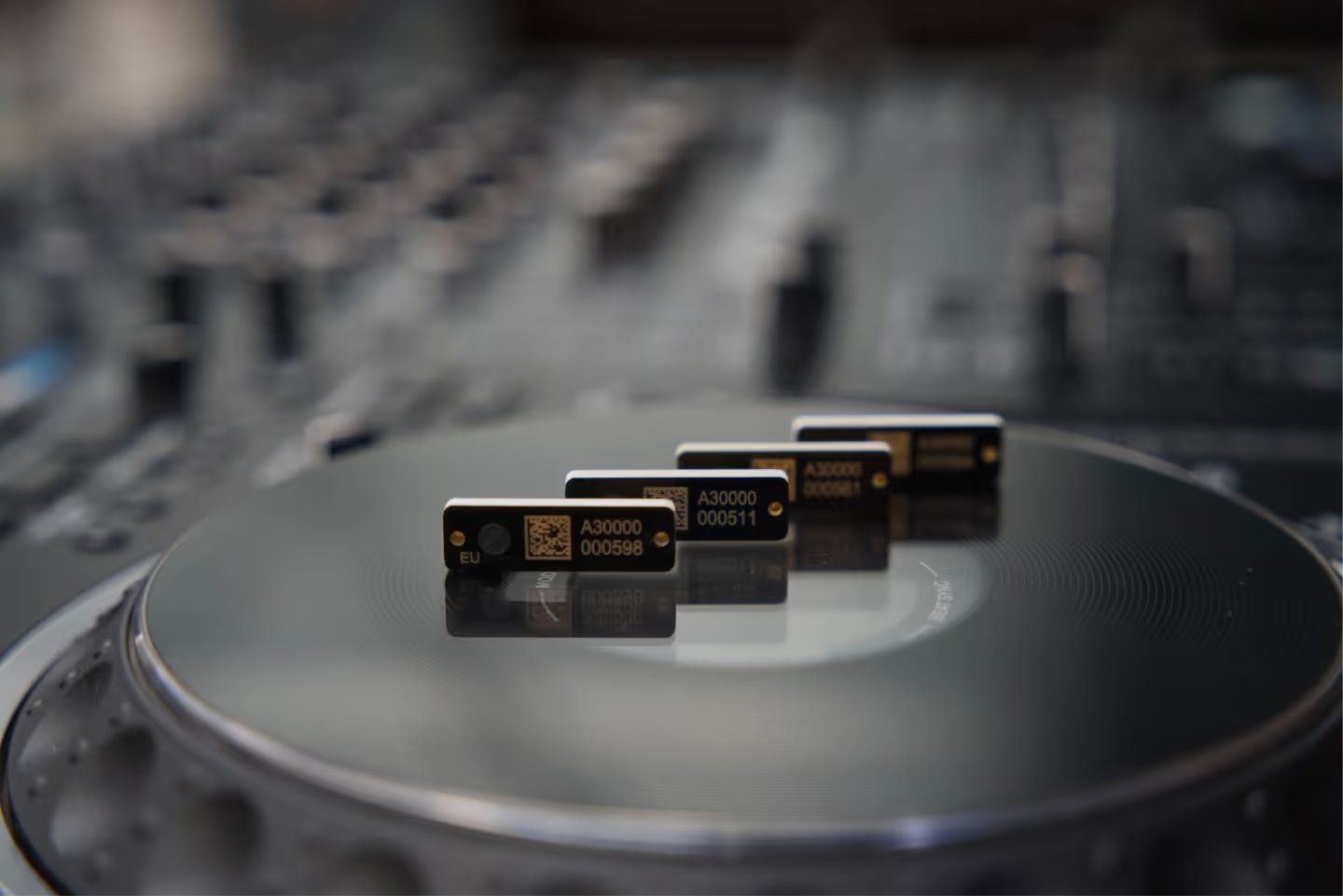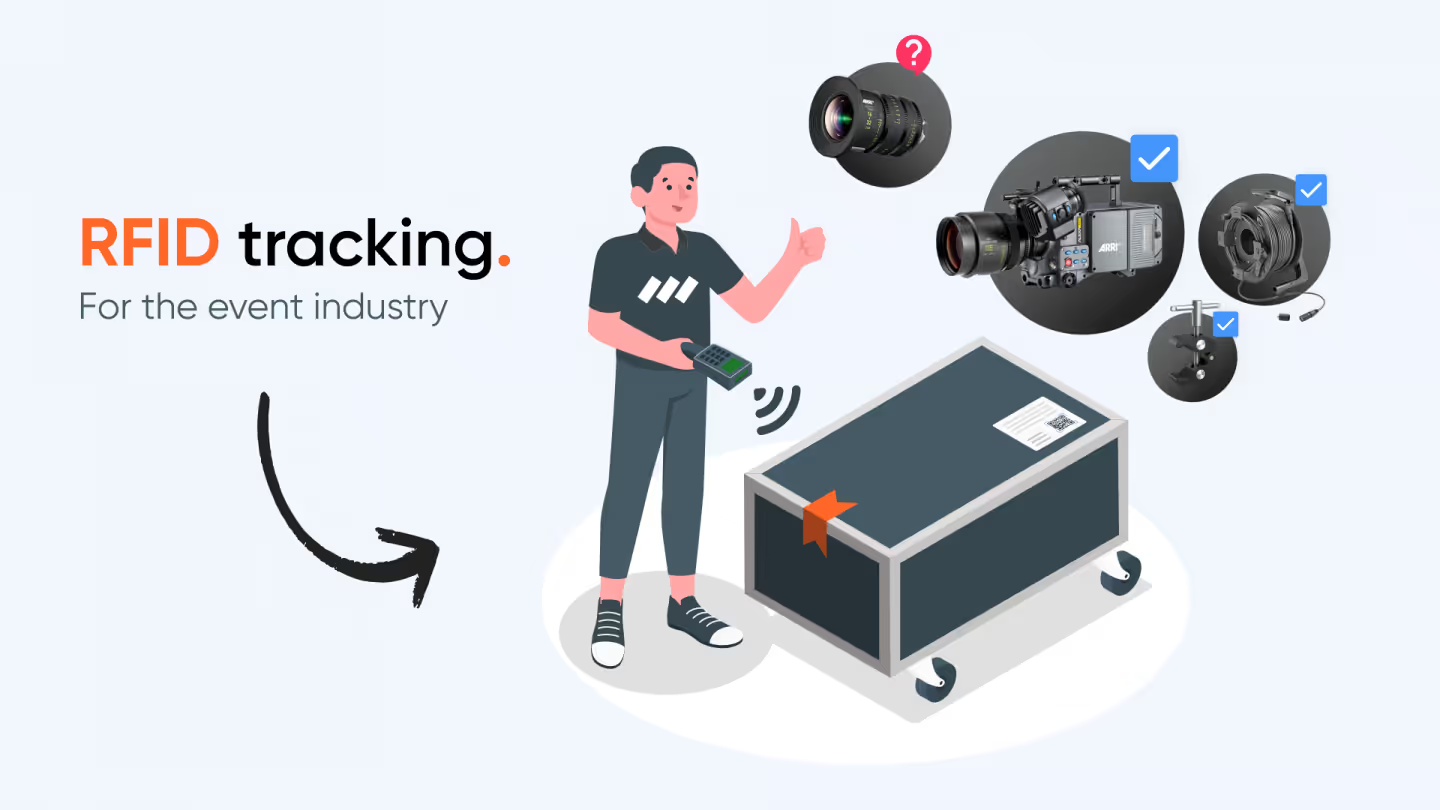Understanding RFID tags in the AV industry: types, uses, and security concerns

You want every event to go smoothly. To keep delivering unforgettable moments to clients while also effectively managing your equipment behind the scenes. Minimizing your losses while increasing your company’s revenue. RFID technology can help you achieve this.
Short for Radio Frequency Identification, RFID is a smart tracking solution used to help companies manage their warehouse inventory and track gear movements during events.
Learn about the different options on the market, so you buy the best tech for your needs, and how to ensure no one else but you has access to your data and gear.
Here’s what we will go over:
1. What is an RFID tag?
2. What is the difference between an RFID tag, label, and inlay?
3. What are the different types of RFID tags?
4. Is RFID the same as NFC?
5. What is an RFID reader?
6. How secure is RFID?
What is an RFID tag?
A radio frequency identification (RFID) tag is a tracking system that uses radio frequency to search, identify, track, and communicate with items and people.
RFID tags use radio frequency to transmit data from the tag to a reader, which then transmits the information to an RFID computer program. RFID tags are frequently used for merchandise, but they can also be used to track vehicles and equipment but can also be used to track pets.
What is the difference between an RFID tag, label, and inlay?
RFID tags come in many shapes and forms. Therefore, simply buying a tag and sticking it on your gear may not accomplish what you need.
There are three different types of RFID systems you need to be aware of. They are all used to identify and track objects, but they differ in their construction and application. Here's how:
- RFID tags: Tags are external electronic devices that are either attached or embedded into objects so you can track them. For example, think of anti-theft tags attached to clothes. However, they come in different shapes and sizes like cards or keychains to name a few options. Tags are made up of a microchip and an antenna that can store information and communicate with a reader using radio waves.
- RFID labels: Labels are a type of RFID tag designed to be glued to the surface of an object. It's like a sticker that contains the RFID tag's microchip and antenna. RFID labels are commonly used for tracking items, inventory management, or identifying products in stores.
- RFID inlays: An inlay is the internal part of an RFID label. It consists of the RFID tag's microchip and antenna. Inlays are usually supplied as a roll or sheet and can be easily integrated into the label printing process. It's like the "guts" of the label that enables it to work. They are designed to be embedded into other objects, such as plastic cards, labels, or packaging materials.

What are the different types of RFID tags?
In addition to different types of RFID systems, RFID technology can be classified into two different categories depending on their power source: active and passive tags.
Why is this important? Because each tag comes with its own price tag, advantages, and applications.
So let’s jump in.
Active RFID Tags
Active RFID tags work via batteries and actively transmit a constant signal to the reader. They have the widest reading range of any RFID tag. However, this comes with a high price tag due to the battery and transmitter needed. Therefore, this is only worth it for high-value items such as large pieces of equipment.
But active RFID tags enable real-time tracking capabilities. Using them leads to more efficient inventory management and reduces the risk of misplaced or lost equipment. Make sure the right gear is at the right place at the right time and stop losing equipment at events.
Passive RFID Tags
Passive RFID tags are the most common. Why? Probably because of their smaller size and they boast a much lower price tag. However, this comes at the cost of a shorter read range
Passive RFID tags have no internal power source. Instead, these are powered by the energy transmitted from an RFID reader. Meaning, the tag will only give you information when you ask for it via the reader. So no real-time information.
How can your event or audio company use passive RFID tags? To track inventory levels and movements within your warehouse. In addition to documenting and tracking equipment through all stages of an event.
Are RFID tags the same as NFC tags?
The short answer to that question is no.
NFC is a subset of RFID technology, but it has some clear differences and limitations when compared to RFID.
NFC does allow for two-way communication between a tag and a reader. For example, think of contactless card payments. However, NFC only operates at very short distances, around 10 cm. More than that and the tag and reader won’t be able to communicate with the reader.
Here are the crucial distinctions between RFID tags and NFC.
What is an RFID reader?
Armed with RFID tags and labels, you need to be able to read them. For this, you need a specific RFID reader. A device that wirelessly communicates with your RFID tags to retrieve and process information stored on them.
Here’s the technical lowdown. The RFID reader emits radio frequency signals and when an RFID tag comes within range of the reader's signal, it initiates communication. The reader captures the tag's response, which includes unique identification data and any additional information stored on the tag.
What is a handheld RFID reader?
You need a reader to keep track of your gear and its movements. But, when working at events, you’re often on the go. So a fixed RFID reader won’t work and isn’t convenient. Therefore, a solution is to invest in a handheld RFID reader.
Handheld RFID readers have integrated antennas, a display, and are equipped with wireless communication capabilities, such as Bluetooth or Wi-Fi. Enabling you to easily connect your RFID reader to other devices like smartphones, tablets, or computers.
Can I scan RFID tags using my phone?
The shorter answer is yes, but you need to use a phone supporting Near Field Communication (NFC) technology. Smartphones with built-in NFC technology can act as handheld RFID readers and scan tags. Note! Rentman only supports RFID scanning with Zebra devices. Read more here.

How secure are RFID tags?
RFID makes it easier to streamline operations, manage the movement of gear, and ensure events go smoothly. However, when implementing the technology, it’s good to be mindful of the potential security risks involved.
One of the primary concerns of RFID is its security. Stealing a tag won’t lead to much, but robbing the data that’s on it is a big cause for fear. Because what if someone acquires unauthorized access or clones of RFID tags? Meaning people could gain access to unauthorized areas and steal valuable equipment.
To diminish the likelihood of this happening, put in place encryption measures to secure the data found on RFID tags and to establish secure communication between your reader and RFID tags. Ensuring only authorized readers can access information while reducing the likelihood of unauthorized access or data interception.
Another solution you can apply to protect your RFID technology and gear is to implement access controls. Meaning you control who has access and can use your RFID readers. Doing so reduces the risk of unauthorized personnel or other companies gaining access to your gear or secure areas.
What is an RFID gate entry system?
Another security option that could be used to store and secure your gear during larger events is a gate entry system.
What’s that? It’s a way of using RFID technology to control access to a specific area or building.
It consists of a gate or door equipped with RFID readers and antennas, as well as RFID tags or access cards assigned to authorized individuals.
Example: when someone with an RFID tag approaches the gate, the RFID reader detects the tag's presence within its range. If the tag is authorized, the gate opens, allowing the person to enter. If the tag is not recognized or unauthorized, the gate remains closed, denying access. Ensuring that only authorized employees can enter storage units and specific areas and stopping people with counterfeit tags from accessing your equipment.
Making it easier to secure large amounts of gear.
The bottom line
RFID can be used for many purposes. Therefore, pick the right system for your needs and depending on your type of gear inventory.
Then, implement security measures to ensure your data, gear, and storage areas are safe.
Do this and watch as you minimize gear loss, increase your warehouse efficiency, and your company’s bottom line.
FAQ
Frequently asked questions
No items found.
Previous blog posts
A complete guide to RFID - What is it, and how does it work?
A complete guide to RFID - What is it, and how does it work?


